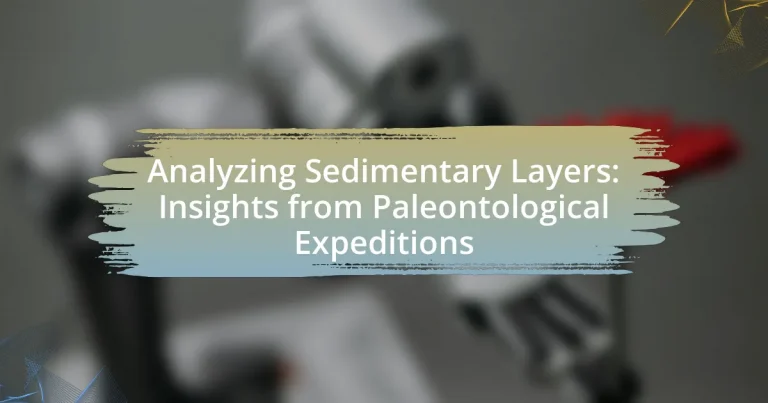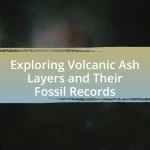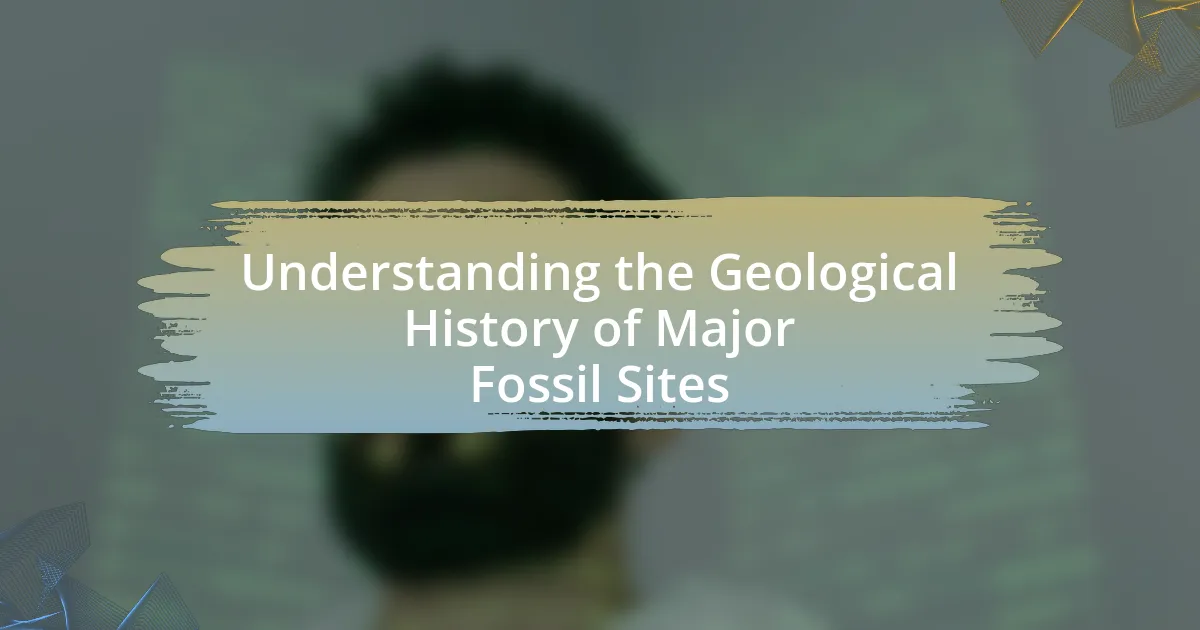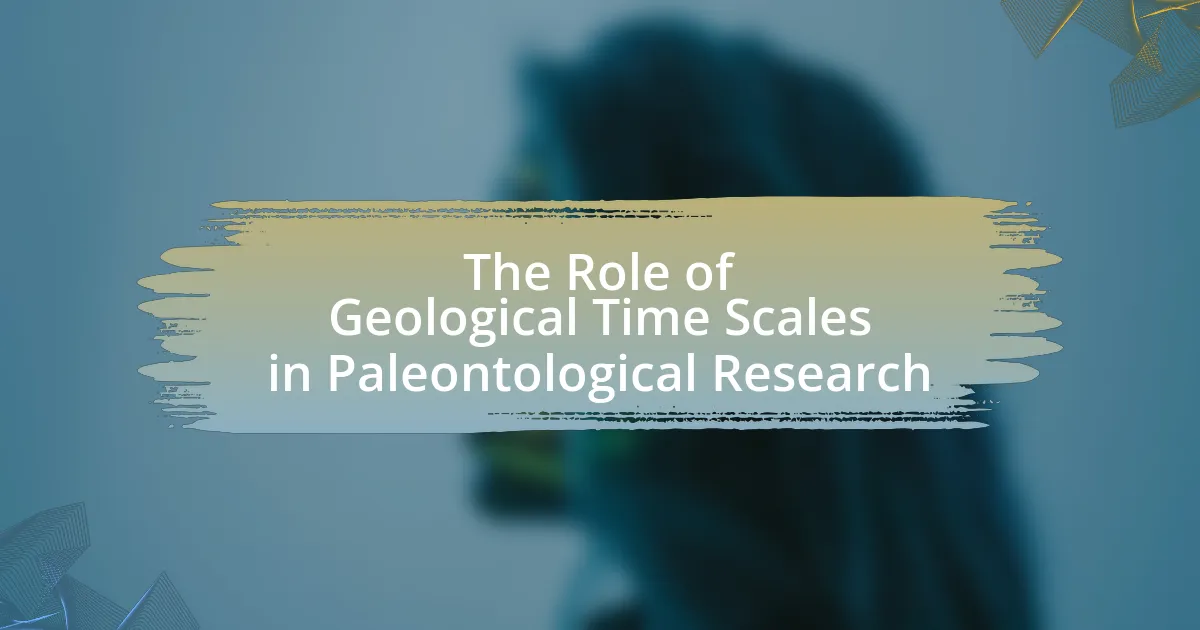Sedimentary layers are distinct strata of rock formed by the accumulation of sediment, playing a vital role in paleontology by providing a chronological record of Earth’s history. This article explores the formation of sedimentary layers, the processes influencing their deposition, and their significance in understanding past climates and ecosystems. It highlights the types of fossils commonly found within these layers and the methodologies used by paleontologists to analyze them, including stratigraphic analysis and geochemical techniques. Additionally, the article addresses the challenges researchers face in fieldwork and data interpretation, emphasizing the importance of collaboration and advanced technologies in enhancing sedimentary layer analysis.

What are Sedimentary Layers and Why are They Important in Paleontology?
Sedimentary layers are distinct strata of rock formed by the accumulation of sediment over time, often containing fossils and organic materials. These layers are crucial in paleontology because they provide a chronological record of Earth’s history, allowing scientists to date fossils and understand the environmental conditions of past ecosystems. For instance, the presence of specific fossilized organisms within these layers can indicate the age of the sediment and the climate during that period, enabling researchers to reconstruct ancient habitats and evolutionary processes.
How do sedimentary layers form over time?
Sedimentary layers form over time through the accumulation and compaction of sediments, which are particles derived from the weathering and erosion of rocks, organic materials, and minerals. These sediments are transported by water, wind, or ice and eventually settle in various environments such as riverbeds, lakes, and oceans. Over time, the weight of overlying materials compresses the sediments, leading to lithification, where they become solid rock. This process is evidenced by the presence of distinct layers, or strata, that can be observed in geological formations, often containing fossils that provide insights into the Earth’s history and past environments.
What processes contribute to the deposition of sedimentary layers?
The processes that contribute to the deposition of sedimentary layers include weathering, erosion, transportation, and sedimentation. Weathering breaks down rocks into smaller particles, while erosion transports these particles through agents like water, wind, and ice. Once the particles are transported, they settle in various environments, such as riverbeds, lakes, and oceans, through the process of sedimentation. This layering occurs over time, with finer particles settling on top of coarser ones, creating distinct sedimentary layers. The validity of this explanation is supported by geological studies that demonstrate how sedimentary rocks form in response to these processes, as seen in the stratification of sedimentary formations across different geological settings.
How do environmental factors influence sedimentation?
Environmental factors significantly influence sedimentation by affecting the rate and composition of sediment deposition. For instance, factors such as water flow velocity, vegetation cover, and climate conditions determine how sediments are transported and settled. High water flow can erode sediments from one area and deposit them in another, while low flow conditions may lead to sediment accumulation. Additionally, vegetation can stabilize soil and reduce erosion, thereby influencing sediment availability. Climate impacts, such as rainfall patterns and temperature, also affect sediment transport processes, with increased rainfall leading to higher runoff and sediment mobilization. Studies have shown that these environmental factors collectively shape sedimentary layers, providing insights into past ecological conditions and geological events.
What role do sedimentary layers play in understanding Earth’s history?
Sedimentary layers are crucial for understanding Earth’s history as they provide a chronological record of geological and biological events. These layers accumulate over time, capturing information about past environments, climate changes, and the evolution of life. For instance, the presence of specific fossils within these layers allows scientists to date the strata and correlate them with known geological periods, such as the Cambrian or Jurassic. Additionally, variations in sediment composition can indicate shifts in climate or tectonic activity, further enriching our understanding of Earth’s dynamic history.
How can sedimentary layers reveal past climates and ecosystems?
Sedimentary layers reveal past climates and ecosystems by preserving physical, chemical, and biological evidence of environmental conditions over time. These layers contain fossils, which provide insights into the types of organisms that existed, indicating the climate and ecosystem characteristics of that period. For example, the presence of certain plant fossils can suggest a warm, humid climate, while marine fossils indicate historical sea levels and ocean conditions. Additionally, isotopic analysis of sediment can reveal temperature variations and changes in precipitation patterns, further elucidating past climate conditions. Studies, such as those conducted by the Geological Society of America, demonstrate how sedimentary records can be correlated with known climatic events, validating their role as archives of Earth’s history.
What types of fossils are commonly found in sedimentary layers?
Common types of fossils found in sedimentary layers include body fossils, trace fossils, and microfossils. Body fossils, such as bones, teeth, and shells, represent the physical remains of organisms. Trace fossils, like footprints and burrows, provide evidence of the behavior and activities of ancient life. Microfossils, which are tiny remains such as pollen and foraminifera, are crucial for understanding past environments and ecological conditions. These fossils are typically preserved in sedimentary rock due to the conditions that favor fossilization, such as rapid burial and low oxygen levels, which inhibit decomposition.

What Insights Can Paleontological Expeditions Provide from Analyzing Sedimentary Layers?
Paleontological expeditions provide insights into the Earth’s historical climate, biodiversity, and evolutionary processes by analyzing sedimentary layers. These layers contain fossils and geochemical signatures that reveal information about past environments, such as temperature, vegetation, and the presence of water. For instance, the discovery of specific fossilized plants in a sedimentary layer can indicate the climate conditions of that era, while isotopic analysis of sediments can provide data on ancient ocean temperatures. Such analyses have led to significant findings, including the understanding of mass extinction events and the evolution of species over millions of years.
How do paleontologists collect data from sedimentary layers?
Paleontologists collect data from sedimentary layers primarily through stratigraphic analysis, which involves examining the sequence, composition, and distribution of rock layers. They utilize techniques such as sediment sampling, fossil identification, and radiometric dating to gather information about the geological history and the organisms that lived during different periods. For instance, sediment samples can reveal the types of materials deposited over time, while fossil identification helps in understanding the biodiversity and ecological conditions of past environments. Radiometric dating provides precise age estimates for the layers, allowing paleontologists to construct timelines of biological and environmental changes.
What tools and techniques are used in sedimentary layer analysis?
Sedimentary layer analysis employs various tools and techniques, including stratigraphic correlation, sediment sampling, and geophysical methods. Stratigraphic correlation allows geologists to compare layers across different locations, identifying similarities and differences in sediment composition and age. Sediment sampling involves collecting physical samples for laboratory analysis, which can reveal information about the depositional environment and past biological activity. Geophysical methods, such as seismic reflection and ground-penetrating radar, provide non-invasive means to visualize subsurface structures and stratigraphy. These techniques collectively enhance the understanding of sedimentary processes and the geological history recorded in sediment layers.
How is stratigraphy applied in paleontological studies?
Stratigraphy is applied in paleontological studies by analyzing sedimentary layers to understand the chronological sequence of fossilized organisms. This method allows paleontologists to determine the relative ages of fossils based on their stratigraphic context, which is essential for reconstructing past ecosystems and evolutionary histories. For instance, the Law of Superposition states that in undisturbed layers, older strata lie beneath younger ones, enabling researchers to date fossils and correlate them with geological time scales. Additionally, biostratigraphy utilizes fossil assemblages within these layers to establish correlations between different geographic locations, enhancing the understanding of biodiversity and extinction events throughout Earth’s history.
What discoveries have been made through sedimentary layer analysis?
Sedimentary layer analysis has led to significant discoveries regarding Earth’s historical climate, biodiversity, and geological events. For instance, researchers have identified patterns of ancient climate change by studying isotopic compositions in sediment cores, revealing periods of glaciation and warming. Additionally, fossilized remains found within these layers have provided insights into the evolution and extinction of species, such as the mass extinction event at the end of the Cretaceous period, which is evidenced by a distinct layer of iridium-rich clay. These findings underscore the importance of sedimentary layers in reconstructing past environments and understanding the dynamics of Earth’s history.
What significant fossil finds have emerged from specific sedimentary layers?
Significant fossil finds have emerged from specific sedimentary layers, including the discovery of dinosaur fossils in the Late Jurassic Morrison Formation, which spans several states in the United States. This formation has yielded numerous well-preserved specimens, such as the Allosaurus and Stegosaurus, providing critical insights into the diversity of dinosaur species during that period. Additionally, the Burgess Shale in Canada, dating back to the Cambrian period, has revealed an exceptional array of soft-bodied organisms, including the famous Hallucigenia, which has contributed to our understanding of early marine ecosystems and the evolution of complex life. These findings underscore the importance of sedimentary layers in paleontological research, as they often contain unique fossil assemblages that reflect the environmental conditions and biological diversity of their respective eras.
How have these discoveries changed our understanding of evolution?
Recent discoveries in paleontology, particularly through the analysis of sedimentary layers, have significantly refined our understanding of evolution by providing clearer timelines and contexts for species development. These findings reveal the gradual changes in biodiversity and the environmental factors influencing evolutionary processes, such as climate shifts and geological events. For instance, the discovery of transitional fossils within specific sedimentary strata has illustrated the gradual evolution of species, supporting the theory of common descent. Additionally, isotopic analysis of sediment layers has allowed scientists to correlate changes in species with historical climate data, demonstrating how external factors drive evolutionary change. This evidence underscores the dynamic interplay between organisms and their environments, reshaping our comprehension of evolutionary mechanisms.

What Challenges Do Researchers Face When Analyzing Sedimentary Layers?
Researchers face several challenges when analyzing sedimentary layers, including the difficulty of distinguishing between layers due to bioturbation, which can disrupt the original stratigraphy. Additionally, the presence of diagenesis can alter the physical and chemical properties of sediments, complicating the interpretation of depositional environments. Furthermore, researchers often encounter issues related to the preservation of fossils within these layers, as factors like erosion and weathering can lead to loss of critical data. These challenges necessitate advanced techniques and interdisciplinary approaches to accurately reconstruct past environments and understand geological history.
What are the common obstacles in fieldwork during paleontological expeditions?
Common obstacles in fieldwork during paleontological expeditions include harsh environmental conditions, logistical challenges, and limited access to sites. Harsh weather, such as extreme temperatures or heavy rainfall, can hinder excavation efforts and damage fragile fossils. Logistical challenges, including transportation of equipment and personnel to remote locations, complicate the planning and execution of expeditions. Limited access to fossil-rich sites due to legal restrictions or difficult terrain further impedes research. These factors collectively impact the efficiency and success of paleontological fieldwork.
How do weather and environmental conditions affect data collection?
Weather and environmental conditions significantly impact data collection by influencing accessibility, equipment functionality, and the integrity of collected samples. For instance, heavy rainfall can lead to flooding, making remote sites unreachable and delaying fieldwork. Extreme temperatures can affect the performance of electronic devices used for data collection, such as GPS units and sensors, potentially leading to inaccurate readings. Additionally, environmental factors like soil moisture levels can alter sediment stability, affecting the quality of samples collected for analysis. Studies have shown that adverse weather conditions can reduce the efficiency of field teams by up to 30%, highlighting the critical role of weather in planning and executing paleontological expeditions.
What limitations exist in interpreting sedimentary records?
Interpreting sedimentary records is limited by factors such as diagenesis, which alters original sediment characteristics, and the incompleteness of the geological record due to erosion or non-deposition. Diagenetic processes can obscure the original depositional environment, making it challenging to reconstruct past conditions accurately. Additionally, sedimentary layers may be missing or disrupted, leading to gaps in the temporal sequence of events. These limitations highlight the complexities involved in accurately interpreting the history preserved in sedimentary deposits.
How can researchers overcome these challenges?
Researchers can overcome challenges in analyzing sedimentary layers by employing advanced technologies such as high-resolution imaging and geochemical analysis. These methods enhance the accuracy of sediment characterization and facilitate the identification of fossilized remains. For instance, the use of X-ray computed tomography (CT) allows for non-destructive examination of sediment structures, revealing intricate details that traditional methods may miss. Additionally, integrating multidisciplinary approaches, including collaboration with geologists and biologists, can provide comprehensive insights into sedimentary environments and fossil contexts, thereby improving the overall understanding of paleoenvironments.
What best practices can enhance the accuracy of sedimentary layer analysis?
To enhance the accuracy of sedimentary layer analysis, employing high-resolution stratigraphic techniques is essential. These techniques include detailed sedimentological mapping, which allows for precise identification of sedimentary structures and facies changes. Additionally, utilizing advanced geochronological methods, such as radiometric dating, provides accurate age estimates for sediment layers, thereby improving chronological frameworks. Research indicates that integrating multidisciplinary approaches, including paleontological data and geochemical analyses, further refines interpretations of depositional environments and processes. For instance, a study published in the Journal of Sedimentary Research highlights that combining sedimentology with biostratigraphy significantly increases the reliability of stratigraphic correlations.
How can collaboration among scientists improve research outcomes?
Collaboration among scientists can significantly improve research outcomes by fostering diverse expertise and facilitating the sharing of resources. When scientists from different disciplines work together, they can integrate various methodologies and perspectives, leading to more comprehensive analyses. For instance, in paleontological expeditions, collaboration allows geologists, biologists, and paleontologists to collectively interpret sedimentary layers, enhancing the understanding of past ecosystems. Studies have shown that interdisciplinary teams produce higher-quality research, as evidenced by a 2017 analysis published in the journal Nature, which found that collaborative papers are cited more frequently than those authored by individuals. This increased citation rate indicates that collaborative efforts yield more impactful and widely recognized research findings.
What are the best practices for analyzing sedimentary layers in paleontological research?
The best practices for analyzing sedimentary layers in paleontological research include systematic stratigraphic logging, careful sampling, and employing geochemical analyses. Systematic stratigraphic logging involves documenting the physical characteristics of sedimentary layers, such as grain size, color, and composition, which helps in understanding the depositional environment. Careful sampling ensures that representative specimens are collected from various depths and locations within the layers, allowing for a comprehensive analysis of the paleontological record. Geochemical analyses, such as stable isotope studies, provide insights into past environmental conditions and biological activity. These practices are supported by studies that emphasize the importance of detailed stratigraphic frameworks in reconstructing ancient ecosystems and understanding evolutionary processes.
How can technology improve the analysis of sedimentary layers?
Technology can improve the analysis of sedimentary layers through advanced imaging techniques, such as high-resolution 3D seismic imaging and ground-penetrating radar. These technologies allow for detailed visualization of subsurface structures, enabling geologists to identify and interpret sedimentary features more accurately. For instance, high-resolution 3D seismic imaging can reveal the stratigraphy and geometry of sedimentary layers, while ground-penetrating radar can detect variations in sediment composition and layering. Studies have shown that these methods enhance the understanding of sedimentary processes and facilitate more precise geological mapping, ultimately leading to better resource management and environmental assessments.
What methodologies yield the most reliable results in sedimentary studies?
The methodologies that yield the most reliable results in sedimentary studies include stratigraphic analysis, sedimentological techniques, and geochronological dating. Stratigraphic analysis allows researchers to understand the layering and distribution of sediments, providing insights into historical geological events. Sedimentological techniques, such as grain size analysis and mineralogical composition, help in interpreting depositional environments and processes. Geochronological dating methods, including radiometric dating and biostratigraphy, establish the age of sediment layers, enhancing the accuracy of temporal correlations. These methodologies are validated by their widespread application in peer-reviewed studies, demonstrating their effectiveness in reconstructing past environments and events.





